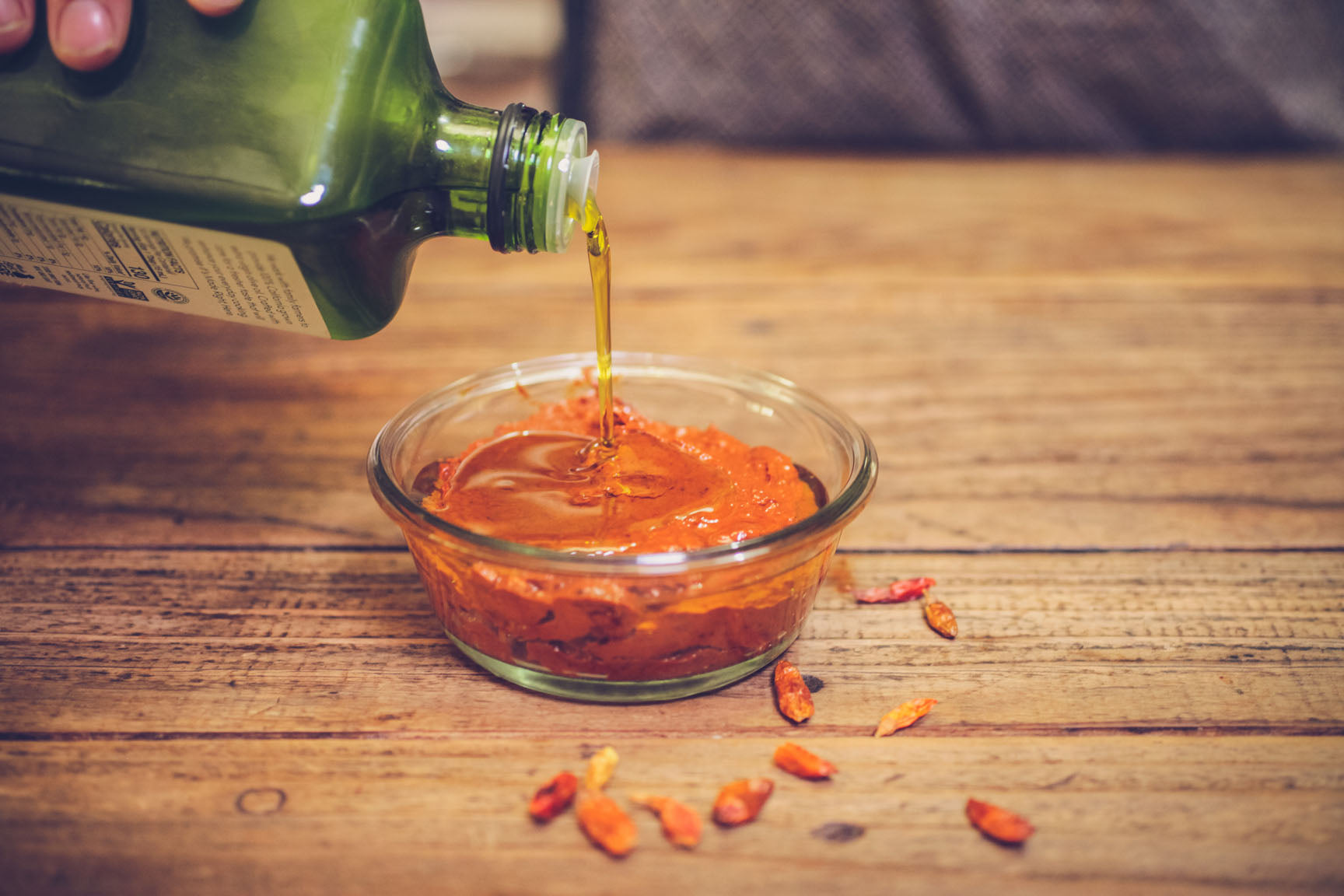- Continue Shopping
- Your Cart is Empty
Harissa

What You'll Need
Equipment
- heatproof container
- tea kettle or small pot to boil water
- cast iron skillet
- mortar and pestle
- high-speed blender
- measuring cups and spoons
- pint mason jar with lid
- silicone spatula
- strainer
Ingredients
- 5 ounces dried chiles, seeded and stemmed
- 2 ounces dried tomatoes
- 2 teaspoons caraway seeds
- 2 teaspoons coriander seeds
- 2 teaspoons cumin seeds
- 4 cloves garlic
- 1/2 teaspoon kosher salt, or to taste
- 2 teaspoons fresh lemon juice, or to taste
- 2 tablespoons olive oil, plus more for storage
- optional additional spices include: cilantro, mint, saffron, rose petals, paprika
Harissa is sometimes described as the national condiment of Tunisia, and it’s a hot item here, as well. Seems like those Moroccan flavors are everywhere on fabulous menus these days. It is no wonder. Harissa is deep and dark and full or fire. A hint of bitterness from the dried pepper skins, a rush of bright acid from lemon juice. Silky and luscious in texture, this combination of dried chiles, garlic, and toasted spices is a versatile and bold condiment, an ingredient you will find yourself reaching for, over and over again.
Use this Moroccan pepper paste in our Merguez sausage recipe, coming soon to a journal near you! Mix it into ground chuck for incredible, fiery hamburgers, or rub it over chicken before and after roasting or grilling. Toss vegetables with harissa and butter or oil before roasting in the oven, or dollop some into soups and stews for instant character. Blend it into yogurt, hummus, guacamole, or salad dressings to add a smoky hot kick to your cool condiment game. Or use it solo, in all its vibrant glory, as a high-octane spread or dip. However you take it in, you’ll soon be burning for more.
Makes about 1 pint
 Directions
Directions
Select chiles to determine flavor and heat level. For this batch, we used a combination of 1.5 oz New Mexico Chiles, .5 oz African Bird peppers, 1 oz Chipotle, and 1 oz Ancho peppers. New Mexico and Ancho peppers are moderately spicy, but the African Birds are hot hot hot! Chipotle are moderately spicy, and smoky to boot. Remove the seeds and stems from dried chiles.  Place the chiles and the sun-dried tomatoes in a heatproof container, and pour boiling water over them to cover.
Place the chiles and the sun-dried tomatoes in a heatproof container, and pour boiling water over them to cover.  Allow to soak and soften for 30 minutes.
Allow to soak and soften for 30 minutes.While the peppers and tomatoes soak, toast the spices in a dry cast iron skillet until fragrant.
 Grind the toasted spices in a mortar and pestle, until they have reached a fine, powdered consistency.
Grind the toasted spices in a mortar and pestle, until they have reached a fine, powdered consistency. Drain the peppers and tomatoes, reserving some of the liquid.
Drain the peppers and tomatoes, reserving some of the liquid. In a blender, combine the soaked chiles and tomatoes with the ground spices, garlic, salt, and lemon juice.
In a blender, combine the soaked chiles and tomatoes with the ground spices, garlic, salt, and lemon juice.  As the blender runs, drizzle in the olive oil and test for consistency. Thin with a bit of the reserved soaking water, if desired.
As the blender runs, drizzle in the olive oil and test for consistency. Thin with a bit of the reserved soaking water, if desired.  The goal is a thick, smooth paste that can be easily spread. Taste and adjust seasoning as desired.
The goal is a thick, smooth paste that can be easily spread. Taste and adjust seasoning as desired.To store harissa, scrape it into a pint jar, and top with olive oil to cover. Replace the olive oil after every use, adding a fresh layer of oil each time to prevent oxidation of the brick-red paste.
 The flavors will deepen and meld over the next several days, but your work is now done. Now you get to enjoy it! Harissa can keep in the refrigerator for up to a month.
The flavors will deepen and meld over the next several days, but your work is now done. Now you get to enjoy it! Harissa can keep in the refrigerator for up to a month.
Over to You
It’s part of our mission here at Mountain Feed to help you make delicious, sustainable, homemade food more often. Stop by and say hello on Facebook, Twitter, Instagram or Pinterest. Or, as always, you can do it the old-fashioned way and come by the store to speak with one of our in-house experts.

 Directions
Directions